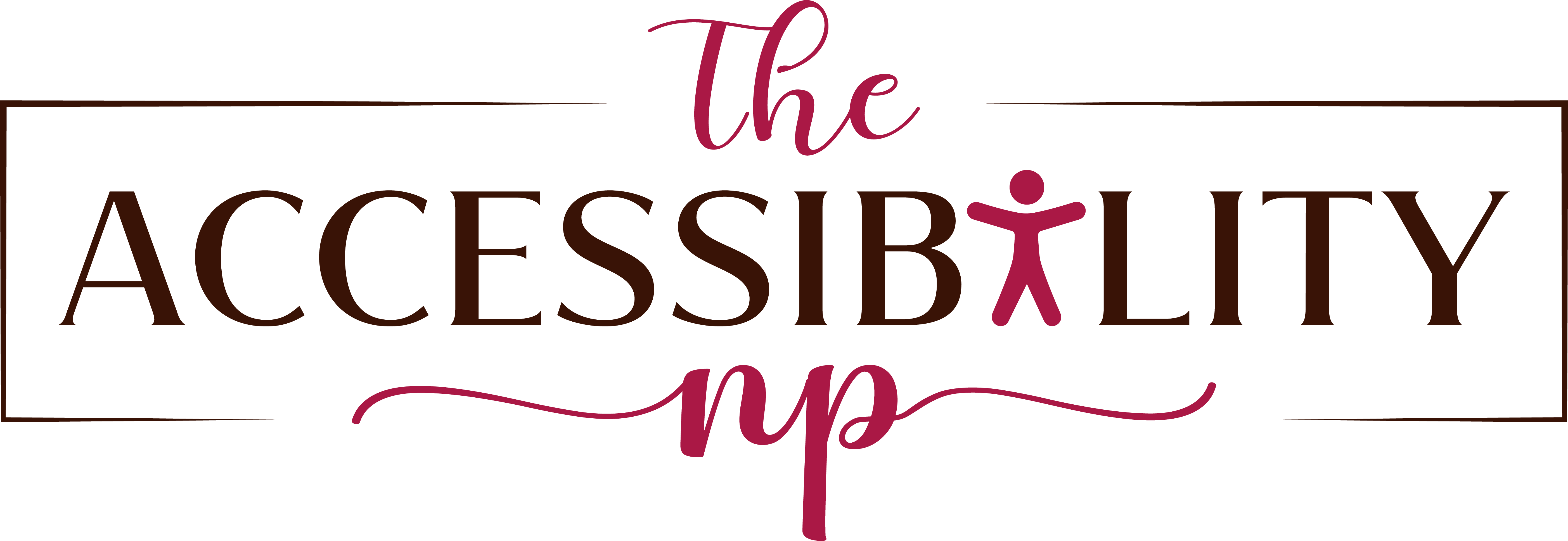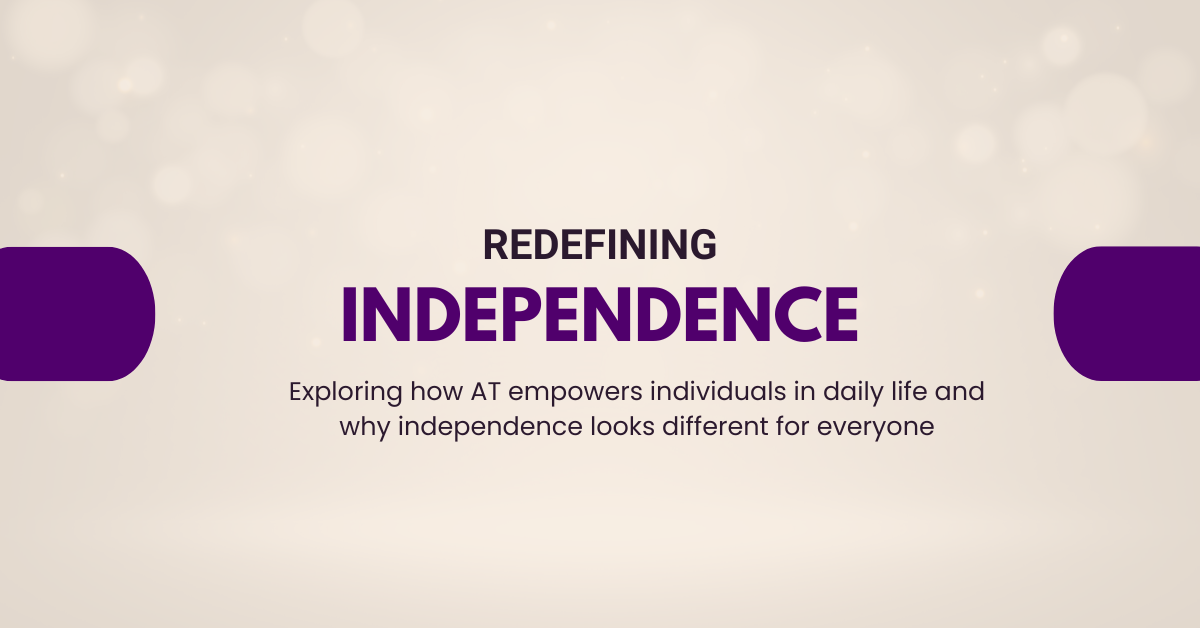Independence is a word that carries deep meaning. For many, it’s often defined by the ability to do things alone—getting dressed, cooking a meal, driving a car, or managing finances without assistance. But for disabled individuals, independence isn’t always about doing things alone. It’s about doing things your way. It’s about access, autonomy, and dignity—having the right tools, supports, and accommodations that allow you to live life on your terms.
Assistive Technology (AT) plays a powerful role in that redefinition. Whether it’s a speech-to-text app, a mobility device, or adaptive switches that make communication possible, AT bridges gaps that traditional environments create. It removes barriers and opens doors to opportunity, expression, and participation.
The truth is that independence doesn’t look the same for everyone—and that’s exactly the point.
What It Means to Be Independent
For generations, society has tied independence to self-sufficiency. But the reality is that no one is truly independent—we all rely on supports every day. The difference is that for disabled individuals, those supports often come in the form of technology, accessibility tools, or human assistance.
Independence isn’t about being separate or self-contained; it’s about having control over decisions, routines, and environments. It’s being able to say I can in your own way. For some, that means walking unassisted. For others, it’s using a power wheelchair to move through the world freely. For some, it’s using eye-gaze technology to write an email, while for others it’s a smartwatch with vibration cues to help stay on schedule.
Assistive Technology expands what independence can look like, and that shift in mindset changes everything.
Assistive Technology as a Pathway to Autonomy
Every piece of Assistive Technology—whether high-tech or low-tech—is built around a single goal: access. From communication to mobility to sensory regulation, AT gives individuals the tools to participate more fully in daily life.
-
Communication and Connection
For non-speaking individuals, Augmentative and Alternative Communication (AAC) devices are life-changing. They offer a voice where there was once silence, allowing people to express wants, needs, humor, and emotions. For many families, the introduction of AAC redefines what connection looks like—conversations become richer, choices more respected, and relationships more balanced. -
Mobility and Access
Mobility devices like wheelchairs, walkers, and scooters are often seen as symbols of limitation by outsiders, but for users, they’re symbols of freedom. They open access to classrooms, workplaces, and communities. With modern innovations like smart wheelchairs and adaptive driving systems, individuals can travel independently and participate in society more fully. -
Daily Living and Executive Functioning
Smart home devices have transformed independence at home. Voice-activated systems allow control over lights, thermostats, doors, and entertainment. For individuals with physical or cognitive barriers, these systems support daily routines without requiring constant assistance. Apps for reminders, timers, and checklists help manage medications, appointments, and schedules—tools that empower people to direct their own day. -
Education and Employment
In schools, AT levels the playing field. Text-to-speech, speech-to-text, visual schedules, and adapted keyboards allow students to demonstrate their knowledge without being limited by their barriers. In the workplace, screen readers, captioning software, and ergonomic tools ensure that everyone can perform and excel. Independence in education and employment doesn’t mean doing everything without help—it means having the right supports to show what you know and do what you do best.
Rethinking “Doing It Alone”
The most powerful shift happens when we stop equating independence with isolation. True independence includes collaboration. It includes interdependence—knowing when and how to use resources to achieve the best outcome.
Think about a student who uses an AAC device to order lunch. They may rely on the cafeteria staff to wait patiently or read the screen, but they’re still communicating independently. Or an adult using a mobility aid who needs help loading it into a car—accepting that assistance doesn’t make them less independent. It means they’re using the supports available to continue moving through their day with autonomy and confidence.
Assistive Technology normalizes this shared independence. It reminds us that independence isn’t diminished by assistance—it’s enhanced by it.
Independence in Context: Personal Stories That Redefine It
Every journey with Assistive Technology tells a story of redefined independence.
A young adult who uses switch access to control their wheelchair and computer isn’t just operating equipment—they’re managing their world. A child who uses visual supports to navigate morning routines isn’t being helped to be independent—they are independent. A professional using adaptive software to meet deadlines isn’t receiving “extra help”—they’re using accessible tools to do their job effectively.
In each case, the individual is empowered to take control of their choices, their time, and their environment. Independence isn’t measured by how much assistance they receive—it’s measured by how freely they can participate in life.
When Technology Becomes Empowerment
Assistive Technology is more than hardware and software—it’s empowerment in tangible form. It represents the intersection of creativity, innovation, and human rights.
-
Access to Choice
Independence begins with choice. Whether it’s choosing what to eat, what to wear, or how to spend time, AT enables decision-making. Communication apps allow individuals to express preferences. Adaptive utensils let someone feed themselves comfortably. Mobility devices offer options about where to go. Each small choice builds a foundation of autonomy. -
Access to Participation
AT isn’t just about function—it’s about inclusion. A student using captioning during class is participating fully in learning. A person using a hearing aid in a meeting is part of the conversation. Independence flourishes when participation becomes possible without unnecessary barriers. -
Access to Dignity
Dignity is central to independence. Being able to complete personal tasks privately or communicate without frustration builds confidence. Assistive Technology supports dignity by giving people ownership of their experiences rather than making them dependent on others for every task.
Why Independence Looks Different for Everyone
Independence is not a single destination—it’s deeply individual. What one person defines as independence might look entirely different for another. For one person, independence might mean walking across a room unassisted; for another, it might mean controlling the environment through a tablet or eye-gaze system.
This diversity in experience should be celebrated, not compared. When we understand that independence has many forms, we begin to create more inclusive environments where everyone’s version of success is valid.
It’s also important to acknowledge that independence can shift over time. As needs change, so does the level or type of support. For instance, someone recovering from an injury might use AT temporarily, while others use it for life. Independence grows and evolves, just like people do.
Barriers to True Independence
While technology offers tremendous opportunities, barriers still exist. Access to funding, training, and appropriate assessments often determines whether someone can obtain the tools they need. Cost, limited awareness, and systemic inequities mean many individuals go without technology that could drastically improve their quality of life.
Another barrier lies in perception. Too often, society views disabled individuals as needing to be “fixed” or made more “independent” in ways that conform to non-disabled norms. But Assistive Technology isn’t about changing the person—it’s about changing the environment to fit them.
Educators, families, and employers all play a role in dismantling those barriers. Advocacy for accessible design, equitable funding, and proper implementation ensures that independence through AT is a right, not a privilege.
Interdependence as the New Model
The modern view of independence embraces interdependence—a model where supports are shared, resources are interconnected, and success is collective.
Interdependence honors the fact that autonomy and support can coexist. It shifts the focus from doing everything alone to having control over how things are done. For instance, someone might use a smart speaker to turn on lights, a caregiver to assist with meals, and an AAC device to communicate—all while being fully independent within their system of supports.
When independence is redefined through interdependence, communities become stronger and more inclusive. Schools, workplaces, and homes evolve into spaces where support isn’t stigmatized—it’s recognized as essential for equity.
The Emotional Side of Independence
There’s an emotional layer to this conversation that often gets overlooked. Gaining independence through Assistive Technology isn’t just about practical outcomes—it’s about confidence, identity, and belonging.
For many individuals and families, the first time a device “works” is transformative. The first message typed on an AAC device. The first text sent with adaptive switches. The first time controlling a wheelchair independently. Those moments carry pride, relief, and joy. They’re reminders that with access comes empowerment—and with empowerment comes possibility.
At the same time, it’s important to recognize that the path to independence can also involve frustration and adjustment. Learning to use technology effectively takes time and patience. Families and professionals must work collaboratively to ensure the tools fit the individual, not the other way around.
Expanding the Definition of Success
Success stories in Assistive Technology aren’t measured by how “normal” someone appears or how little support they need. Success is measured by satisfaction, engagement, and happiness.
A person who uses technology to attend a concert, to write poetry, or to advocate for change is living independently in their own right. The ability to participate fully in life—to love, to learn, to connect—is the ultimate measure of independence.
Every success, big or small, deserves celebration. Independence might be opening an app, pressing a switch, or simply being heard. Each step matters.
Moving Toward a Culture of Access
To truly redefine independence, society must shift toward a culture of access. That means designing environments, systems, and technologies that are inherently inclusive from the start—rather than retrofitted as an afterthought.
Schools should normalize the use of Assistive Technology as part of learning, not as an exception. Workplaces should adopt accessible digital tools and provide accommodations without resistance. Communities should invest in universal design so that public spaces are accessible to all.
When access becomes a standard expectation, independence naturally follows. The goal is not to make individuals fit into inaccessible systems, but to make systems fit the diversity of humanity.
Technology and Humanity Working Hand in Hand
At its core, Assistive Technology is about connection. It connects ability with opportunity, innovation with humanity. It allows individuals to live more fully—not because it erases disability, but because it honors it.
Every time technology supports communication, movement, or learning, it strengthens human connection. It allows voices to be heard, stories to be told, and contributions to be valued. And in doing so, it reshapes what independence means in the modern world.
Final Thoughts
Independence is not a single picture—it’s a mosaic made of countless experiences. Through Assistive Technology, disabled individuals define independence on their own terms. Some use devices that speak for them. Some use tools that move them. Some rely on apps that organize their days or smart devices that make homes accessible. Each path is unique, personal, and valid.
Redefining independence means shifting from a mindset of doing everything alone to having the power to decide how things are done. It’s about access, dignity, and inclusion. It’s about understanding that independence doesn’t need to look the same to be meaningful.
Assistive Technology isn’t just about tools—it’s about possibility. It’s a bridge to autonomy, a celebration of capability, and a reminder that independence is not the absence of support but the presence of choice.
And when we embrace that, we create a world where independence is not measured by what someone can do without assistance—but by how freely they can live, communicate, and belong.

